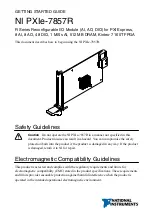
5.4.3
Temperature of Components
Cabinet
Ambient
Temp.
Sensor
Enclosure Example
The equipment can be applied as a distributed system, with multiple enclosures
mounted in remote locations. Temperature sensors and diagnostics are built into the
equipment for continuous monitoring. Each I/O pack’s local processor board contains a
temperature sensor. This sensor is located in close proximity to the main processor on
the I/O pack processor board and is thus positioned to report the approximate
temperature of the main processor itself.
Because this sensor is detecting the internal component temperature, reported
temperatures (which are above the ambient temperature rating of the component for the
enclosure design) are normal and should not be cause for concern. These temperatures
are continuously available in the database and from the ToolboxST application.
Detection of an excessive temperature generates a diagnostic alarm, so if there are no
temperature alarms, then the equipment is within acceptable range for normal
operations. Even if alarms are present, the components themselves should continue to
operate well above the alarm limit. Excessive temperatures can however, limit the life
of the equipment. With the latest version of BPPC-based processor firmware, the
diagnostic alarm for excessive heating is set at 90
°
C.
The equipment should be arranged by following normal wiring practices for separation
of high and low levels, but in a few cases, heat should be considered. Some components
dissipate more heat than others. If there is a significant temperature rise from the bottom
of the enclosure to the top, then electronics with significant heat dissipation should be
mounted lower in the enclosure.
For internal enclosure design considerations, many Mark VIe components have an ambient temperature rating of -40 to 70°C
(-40 to 158 °F). The following table lists only the components with more restrictive ambient ratings.
Mark VIe and Mark VIeS Equipment with Restrictive Ambient Ratings
Equipment
Operating Temperature
UCCA controller
0 to 60°C (32 to 140 °F)
UCCC controller
0 to 50°C (32 to 122 °F)
UCSA controller (also PMVE and PAMC)
UCSBH3A controller
0 to 65°C (32 to 149 °F)
PCNO, PPRF
-20 to 55°C (-4 to 131 °F)
PFFA
0 to 55°C (32 to 131 °F)
YSIL, YDOA
-30 to 65°C (-22 to 149 °F)
All BPPB-based I/O packs
-30 to 65°C (-22 to 149 °F)
Note
All ATEX applications shall remain rated for -30 to 65°C (-22 to 149 °F).
Technical Regulations, Standards, and Environment
GEH-6721_Vol_I_BP System Guide 123
Public Information
Содержание Mark VIe
Страница 61: ...Example UCSx Controller Label Control System Overview GEH 6721_Vol_I_BP System Guide 61 Public Information ...
Страница 66: ...Notes 66 GEH 6721_Vol_I_BP GEH 6721_Vol_I Mark VIe and Mark VIeS Control Systems Volume I Public Information ...
Страница 74: ...Notes 74 GEH 6721_Vol_I_BP GEH 6721_Vol_I Mark VIe and Mark VIeS Control Systems Volume I Public Information ...
Страница 116: ...Notes 116 GEH 6721_Vol_I_BP GEH 6721_Vol_I Mark VIe and Mark VIeS Control Systems Volume I Public Information ...
Страница 164: ...Notes 164 GEH 6721_Vol_I_BP GEH 6721_Vol_I Mark VIe and Mark VIeS Control Systems Volume I Public Information ...
Страница 198: ...Notes 198 GEH 6721_Vol_I Mark VIe and Mark VIeS Control Systems Volume I Public Information ...
Страница 201: ......
Страница 202: ...Public Information ...
















































